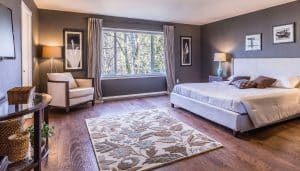When Secondary Glazing Can and Can’t be Fitted, and Choosing the Correct Units by Window Type
Homeowners choose secondary glazed windows because they’re quiet, warm, and secure. These three features are the bedrock of Ventrolla’s unique secondary glazing system and are the reason why so many homeowners are adopting secondary glazing.
Secondary glazing has emerged as a popular solution for improving insulation, reducing noise, and enhancing security in residential and commercial properties. It involves fitting an additional pane of glass to existing windows, creating a barrier that provides added insulation and soundproofing benefits. While secondary glazing offers numerous advantages, it’s essential to understand when it can and can’t be fitted, as well as the correct units to choose based on different window types.

Identifying When Secondary Glazing Can Be Fitted
- Window Frame Condition:
Secondary glazing can typically be fitted to most types of window frames, including wood, metal, and uPVC. However, it’s essential to ensure that the existing window frames are in good condition and structurally sound. - Sufficient Depth:
The depth of the window reveal or recess is crucial for accommodating the secondary glazing unit. Generally, a minimum depth of around 50mm is required for effective installation. If the window reveal is too shallow, alternative solutions may need to be considered. - Access for Installation:
Adequate access around the window area is necessary for installing secondary glazing. If the window is obstructed by fixtures, fittings, or external structures, it may not be feasible to fit secondary glazing without modifications. - Building Regulations:
It’s important to check local building regulations and planning requirements before installing secondary glazing, especially in listed buildings or conservation areas. Some properties may have restrictions on alterations to windows, which could affect the feasibility of secondary glazing installation.
Identifying When Secondary Glazing Can’t Be Fitted
- Severely Damaged Frames:
If the existing window frames are severely damaged or deteriorated, it may not be practical to fit secondary glazing. In such cases, repairs or replacement of the primary windows may be necessary before considering secondary glazing options. - Insufficient Depth:
In properties with particularly shallow window reveals or recesses, there may not be enough space to accommodate secondary glazing units. Attempting to install secondary glazing in such situations could compromise the integrity of the installation or obstruct window functionality. - Structural Limitations:
Structural constraints within the building, such as load-bearing walls, beams, or other architectural features, may restrict the installation of secondary glazing. Professional assessment and consultation may be required to determine the feasibility of installation in such cases. - Historic or Architectural Significance:
Properties with historic or architecturally significant windows may be subject to preservation regulations that prohibit alterations, such as secondary glazing. Preservation guidelines must be carefully considered before undertaking any modifications.
Choosing the Correct Units by Window Type
- Sash Windows:
For traditional sash windows, vertical sliding secondary glazing units are typically recommended. These units can be fitted inside the existing window frame, providing enhanced insulation and soundproofing without compromising the aesthetic appeal of the original windows. Opening from top to bottom, our vertical sliding units are also available with a special slide pass or tilt-in function, which enables both panels to individually pivot inward for easy access and cleaning. - Casement Windows:
Casement windows, which open outward on hinges, can accommodate hinged or fixed secondary glazing units. Hinged units allow for easy access to the primary window for cleaning and ventilation, while fixed units provide permanent insulation and soundproofing benefits. With no transoms or mullions to spoil the view, our hinged secondary glazing windows are a truly unobtrusive secondary glazing option. The unit opens like a door and is available with a multi-point locking system or butt hinges. - Windows with Vertical Bars:
Suitable for a range of windows, including both casement and fixed, our horizontal sliding units open from side to side and are slim, versatile, and easily accessed for both cleaning and ventilation. - Bay Windows:
Bay windows often present unique challenges due to their curved or angled configurations. Custom-made secondary glazing units may be required to fit seamlessly within the bay window structure, providing consistent insulation and soundproofing across all sections. - French Doors:
Secondary glazing units can also be fitted to French doors to improve thermal efficiency and reduce noise transmission. Sliding or hinged units can be installed alongside the primary doors, offering added insulation without obstructing access or functionality. - Windows in Rooms with Limited Access
Our fixed units are independent windows that are permanently fitted on the inside of the existing door or window. They suit rooms where space is limited. We also have lift-out units for windows that require occasional access. Similar to our fixed units in concept and design, but with the ability to easily remove the frames to allow for increased airflow and improved access for cleaning.

In conclusion, while secondary glazing offers a versatile solution for enhancing the performance of existing windows, careful consideration must be given to factors such as window condition, depth, access, and building regulations. By identifying when secondary glazing can and can’t be fitted, as well as choosing the correct units by window type, homeowners can effectively improve insulation, reduce noise, and enhance comfort in their properties. Consulting with experienced professionals can help navigate the complexities of secondary glazing installation and ensure optimal results tailored to specific requirements and constraints.

